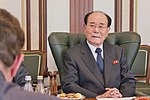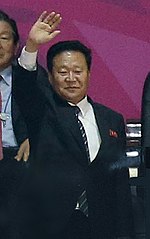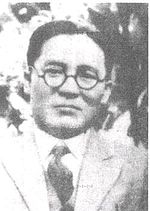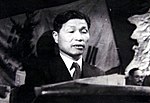Supreme People's Assembly
Supreme People's Assembly 최고인민회의 最高人民會議 Choego Inmin Hoeŭi | |
|---|---|
| 14th Supreme People's Assembly | |
 | |
| Type | |
| Type | Unicameral |
| Leadership | |
Pak Thae-song since 11 April 2019 | |
Vice Chairmen | |
| Structure | |
| Seats | 687 |
 | |
Political groups | Democratic Front for the Reunification of Fatherland (687)
|
| Committees |
|
| Elections | |
Voting system | Approval voting for single party-nominated candidate |
Last election | 10 March 2019 |
| Meeting place | |
 | |
| Mansudae Assembly Hall Pyongyang Democratic People's Republic of Korea | |
| Website | |
| Minju Choson, the official newspaper of the SPA Presidium | |
| Chosŏn'gŭl | |
|---|---|
| Hancha | |
| Revised Romanization | Choego Inmin Hoeui |
| McCune–Reischauer | Ch’oego Inmin Hoeŭi |
Politics of North Korea |
|---|
 |
|
The Supreme People's Assembly (SPA; Korean: 최고인민회의; MR: Ch’oego Inmin Hoeŭi) is the unicameral legislature of the Democratic People's Republic of Korea (DPRK), commonly known as North Korea. It consists of one deputy from each of the DPRK's 687 constituencies,[1] elected to five-year terms.[2]
The constitution identifies the SPA as the "highest organ of state power" and all state positions, including the Supreme Leader, trace their authority to it. The Assembly typically does not legislate directly, but delegates that task to a smaller Standing Committee. The policies legislated by the SPA are carried out by government officials subject to oversight and correction by the Supreme Leader.
The Workers' Party of Korea, which the constitution recognizes as the state's leading party, dominates the Assembly in a monopoly coalition with the Social Democratic Party and the Chondoist Chongu Party called the Democratic Front for the Reunification of the Fatherland. Elections are held in five-year intervals, the most recent taking place in 2019.
History[]
Under the 1972 Constitution, the number of seats in the Assembly was 655.[3] This was increased to 687 following the 1986 election.[4]
In 1990, the composition of the SPA was 601 seats held by the Workers' Party of Korea, 51 seats held by the Korean Social Democratic Party, 22 seats held by the Chondoist Chongu Party and 13 seats held by independents.[5]
The last convention during Kim Il-sung's government took place in April 1994, three months before his death. Then during the mourning period the assembly did not meet, nor did elections take place. The next meeting convened in September 1998, four years after Kim's death.[6]
Kim Jong-il did not make a speech at the first session of the 10th SPA in 1998. Instead, members listened to a tape-recorded speech of the late Kim Il Sung, which was made at the first session of the 9th SPA, in 1991. The enhanced status of the Korean People's Army was anticipated by the SPA election July 1998, when 101 military officials were elected out of 687 delegates. This was a large increase from the 57 military officials elected during the 9th SPA in 1990.
Kim Yong-nam served as president of the Assembly Presidum from 1998 until 2019.[7][8] Pak Thae-song is the Chairman (Speaker), while and are the Vice-Chairmen.[8]
On April 14, 2012, during the fifth session of the 12th Supreme People's Assembly Kim Jong Un was elected as the country's supreme leader. Addressing the SPA session, Kim Yong-nam, president of the SPA Presidium, said Kim's accession to the DPRK's top post reflected "the ardent desire and unanimous will of all the party members, servicepersons and other people".[9] His status as leader was reaffirmed when he was elected unopposed on March 9, 2014. Kim was nominated to represent his district, the symbolic Mount Paekdu, in the assembly election. Voters could vote yes or no, with all voting in the affirmative, according to government officials.
In 2017, the assembly created a subordinate Diplomatic Commission. This may be useful for international dialogue with other parliaments, while other diplomatic channels are blocked.[10] On 11 April 2019, Choe Ryong-hae was appointed President of the Presidium.[11]
Tenures[]
| Term | Deputies | Start | End | Duration | |||
|---|---|---|---|---|---|---|---|
| 1st | 572 | 2 September 1948 | 18 September 1957 | 9 years, 16 days | |||
| 2nd | 215 | 18 September 1957 | 22 October 1962 | 5 years, 34 days | |||
| 3rd | 383 | 22 October 1962 | 14 December 1967 | 5 years, 53 days | |||
| 4th | 457 | 14 December 1967 | 12 December 1972 | 4 years, 364 days | |||
| 5th | 541 | 12 December 1972 | 15 December 1977 | 5 years, 3 days | |||
| 579 | 15 December 1977 | 5 April 1982 | 4 years, 111 days | ||||
| 7th | 615 | 5 April 1982 | 29 December 1986 | 4 years, 268 days | |||
| 655 | 29 December 1986 | 24 May 1990 | 3 years, 146 days | ||||
| 9th | 687 | 24 May 1990 | 5 September 1998 | 8 years, 104 days | |||
| 10th | 687 | 5 September 1998 | 3 September 2003 | 4 years, 363 days | |||
| 11th | 687 | 3 September 2003 | 9 April 2009 | 5 years, 218 days | |||
| 12th | 687 | 9 April 2009 | 9 April 2014 | 5 years, 0 days | |||
| 13th | 687 | 9 April 2014 | 11 April 2019 | 5 years, 2 days | |||
| 14th | 687 | 11 April 2019 | Incumbent | 2 years, 142 days | |||
| References: [12] | |||||||
Elections and membership[]
Under the Constitution of North Korea, all citizens 17 and older, regardless of party affiliation, political views, or religion, are eligible to be elected to the legislature and vote in elections.
All candidates are selected by the Democratic Front for the Reunification of the Fatherland in mass meetings held to decide which candidates will be nominated and their names can only go on the ballot paper with the approval of the meeting. The Democratic Front for the Reunification of the Fatherland is a popular front dominated by the Korean Worker's Party, in which almost all power rests. The other participants in the coalition include the two other de facto legal political parties, the Korean Social Democratic Party and the Chondoist Chongu Party, as well as various other member organizations including social groups and youth groups, such as the Korean Children's Union, the Kimilsungist-Kimjongilist Youth League, the Korean Democratic Women's League, and the Red Cross Society of the Democratic People's Republic of Korea.
Only one candidate who has been selected by the Democratic Front for the Reunification of the Fatherland appears on the ballot. A voter may cross off the candidate's name to vote against them, but must do so in a special booth without any secrecy.[13] The voter must then drop his or her ballot into a separate box for "no" votes. Voting against a Democratic Front candidate is considered treasonous; those who do face the loss of their jobs and housing, along with extra surveillance. Refusing to vote at all is also considered a treasonous act.[14]
Functions[]
The Assembly is convened once or twice a year in regular sessions of several days each. At all other times, the Standing Committee acts for the Assembly. Extraordinary sessions of the Assembly can also meet when called by the Standing Committee or by one third of the Assembly deputies.
The functions of the SPA are:[15]
- Adopting, amending or supplementing enactments to the constitution;
- enact, amend and supplement statutory laws
- approve major statutory laws adopted by the SPA Standing Committee while the SPA is in recess
- establish the basic principles of the state's domestic and foreign policies
- Determining State policy and budgets;[16]
- Elections of the President, Vice-Presidents and members of the State Affairs Commission;
- Elections of the Chairman, Vice Chairman and other members of the Standing Committee;
- Elections of legal officials;
- Appointing the Premier, Deputy Premiers and other members of the Cabinet
- Receiving reports and adopting measures on the Cabinet
- Elect or recall the chief justice of the Central Court
- Elect or recall the prosecutor general of the Central General Prosecutor's Office
Constitutional amendments require the approval of two-thirds of the deputies.[15]
Standing Committee[]
The Standing Committee exercises legislative power when the SPA is in recess, which occurs during all but a few days of every year. For all intents and purposes, it is the highest organ of state power in North Korea.[7]
The Standing Committee consists of the Chairman, Vice-Chairmen, a Secretary-General and other members, elected by the SPA.[17] The Secretary-General, a largely symbolic role,[18] is currently .[8] The functions of the Standing Committee are to:
- Convene sessions of the Supreme People's Assembly;[15]
- Examine and approve new state legislation when the SPA is in recess;[15]
- Supervise the when the SPA is not in session;[19]
- Supervise the Central Court when the SPA is in recess;[20]
- Interpret and enact the Constitution and most legislation passed, with the President of the State Affairs Commission (SAC) now having the power to enact important laws presented for legislation;[15]
- Form or dissolve state ministries;[15]
- Supervise laws of State organs;[15]
- Supervise parliamentary committees;[17]
- Organize elections to the Supreme People's Assembly;[15]
- Ratify treaties with foreign countries;[15]
- Appoint, transfer, or remove officials and judges when the SPA is in recess;[15]
- Grant special pardons or amnesties.[15]
In addition to its executive functions, the Standing Committee also receives credentials of diplomatic representatives from foreign countries with the consent of the President of the SAC.[15]
In 1998, a constitutional amendment abolished the posts of the President of North Korea, , and Standing Committee of the Supreme People's Assembly and gave their powers to a new body titled the Presidium of the Supreme People's Assembly.[21] Of these organs, the Presidium was seen as the successor of the Standing Committee.[22] In 2021, the Presidium reverted its name back to Standing Committee, though the powers provided by the original constitutional amendment used to abolish the previous Standing Committee remain unaltered. Thus, the Standing Committee formed in 2021 currently serves as a continuation of the Presidium rather than a re-creation of the Standing Committee that had existed before 1998.[23]
| Position | Name | Ref |
|---|---|---|
| President | Choe Ryong-hae | [8] |
| Vice President | Pak Yong-il | [8] |
| Vice President | Thae Hyong-chol | [8] |
| Secretary General | [8] | |
| Member | Kim Yong-chol | [8] |
| Member | [8] | |
| Member | [8] | |
| Member | [8] | |
| Member | [8] | |
| Member | [8] | |
| Member | Pak Myong-chol | [8] |
| Member | Kim Nung-o | [8] |
| Member | [8] | |
| Member | [8] | |
| Member | Ri Chol | [8] |
Chairman[]
Prior to the creation of the post of President of the DPRK in 1972, the Chairman of the Standing Committee was the country's de jure head of state.[citation needed] Currently, the Chairman of the Supreme People's Assembly is the SPA speaker,[24] while the Chairman of the Standing Committee performs certain representative functions ordinarily accorded to a head of state.[citation needed] As the representative of the state in external matters and the head of the highest sovereign organ, the Chairman of the Standing Committee is often considered the de facto head of state of North Korea, though officially this role is reserved for the President of the State Affairs Commission. The Chairman also convenes sessions of the SPA.[22]
The Chairman, like the rest of the Standing Committee, is elected by the SPA, which can also remove the Chairman. Choe Ryong-hae assumed the office of President of the Presidium of the Supreme People's Assembly in 2019 before the office was given the current name in 2021.[8]
Committees[]
In addition to the Standing Committee, the SPA has four parliamentary committees: the Foreign Affairs Committee, Budget Committee, Legislation Committee,[8] and Deputy Credentials Committee.[25] The constitution mandates the Legislation and Budget Committees and leaves the choice of having more committees to the SPA.[26] Before 1998, there was an additional committee called the Reunification-policy Deliberation Committee.[22] The Foreign Affairs Committee, too, was discontinued in 1998,[22] but as of 2019 is operating again.[8]
Foreign Affairs Committee[]
The Foreign Affairs Committee is chaired by Ri Su-yong. The other members are , Ri Son-gwon, Kim Jong-suk, , Choe Son-hui, and Kim Song-il.[8]
Budget Committee[]
The Budget Committee is chaired by O Su-yong. The other members are , , Ri Hi-yong, , , and .[8]
Legislation Committee[]
The Legislation Committee is chaired by Choe Pu-il. The other members are , , Pak Jong-nam, , , and .[8]
Deputy Credentials Committee[]
The Deputy Credentials Committee is chaired by Kim Phyong-hae.[25]
List of office holders[]
| Chairman of the Standing Committee of the Supreme People's Assembly of the Democratic People's Republic of Korea | |||||||
|---|---|---|---|---|---|---|---|
| Chairman | Political party | Term Start | Term End | Election | Ref | ||

|
Kim Tu-bong 김두봉 1889–1958 |
Workers' Party of North Korea | 9 September 1948 | 20 September 1957 | 1st SPA | ||
| Workers' Party of Korea | |||||||
| Choe Yong-gon 최용건 1900–1976 |
Korean Democratic Party | 20 September 1957 | 23 October 1962 | 2nd SPA | |||
| Workers' Party of Korea | |||||||
| 23 October 1962 | 16 December 1967 | 3rd SPA | |||||
| 16 December 1967 | 28 December 1972 | 4th SPA | |||||

|
Hwang Jang-yop 황장엽 1923–2010 |
Workers' Party of Korea | 28 December 1972 | 16 December 1977 | 5th SPA | ||
| 16 December 1977 | 6 April 1982 | 6th SPA | |||||
| 6 April 1982 | 7 April 1983 | 7th SPA | |||||

|
Yang Hyong-sop 양형섭 (born 1925) |
Workers' Party of Korea | 7 April 1983 | 29 December 1986 | |||
| 29 December 1986 | 24 May 1990 | 8th SPA | |||||
| 24 May 1990 | 5 September 1998 | 9th SPA | |||||
| President of the Presidium of the Supreme People's Assembly of the Democratic People's Republic of Korea | |||||||
| President | Political party | Term Start | Term End | Election | Ref | ||

|
Kim Yong-nam 김영남 (born 1928) |
Workers' Party of Korea | 5 September 1998 | 3 September 2003 | 10th SPA | ||
| 3 September 2003 | 9 April 2009 | 11th SPA | |||||
| 9 April 2009 | 9 April 2014 | 12th SPA | |||||
| 9 April 2014 | 11 April 2019 | 13th SPA | |||||

|
Choe Ryong-hae 최룡해 (born 1950) |
Workers' Party of Korea | 11 April 2019 | Incumbent | 14th SPA | [8] | |
| Chairman of the Assembly of Supreme People's Assembly of the Democratic People's Republic of Korea | |||||||
| Chairman | Political party | Term Start | Term End | Election | Ref | ||

|
Ho Hon 허헌(許憲) (1885-1951) |
Workers' Party of Korea | September 1948 | 1951 | 1st SPA | ||

|
Paek Nam-un 백남운 (1894-1979) |
Workers' Party of Korea | 25 November 1957 | 1972 | 4th SPA | ||
| Han Duk-su 한덕수 (1907-2001) |
Workers' Party of Korea | 1972 | 1986 | 5th SPA 14th SPA 6th SPA 7th SPA |
|||
| Chairman of the Supreme People's Assembly of the Democratic People's Republic of Korea | |||||||
| Chairman | Political party | Term Start | Term End | Election | Ref | ||
| Choe Thae-bok 최태복 (born 1930) |
Workers' Party of Korea | 5 September 1998 | 11 April 2019 | 10th SPA 11th SPA 12th SPA 13th SPA |
|||

|
Pak Thae-song 박태성 (born 1955) |
Workers' Party of Korea | 11 April 2019 | Incumbent | 14th SPA | ||
See also[]
- Politics of North Korea
- List of legislatures by country
- National Assembly, the South Korean legislature
References[]
Citations[]
- ^ "DEMOCRATIC PEOPLE'S REPUBLIC OF KOREA Choe Go In Min Hoe Ui (Supreme People's Assembly)". Inter-Parliamentary Union. 5 August 2014. Retrieved 3 January 2018.
- ^ "DPRK Holds Election of Local and National Assemblies". People's Korea. Archived from the original on 2013-03-31. Retrieved 2008-06-28.
- ^ Gorvin, Ian (1989-01-01). Elections since 1945: a worldwide reference compendium. Longman. p. 196. ISBN 9780582036208.
- ^ Publications, Europa; Staff, Europa Publications; 32nd, Ed (2017-04-25). The Far East and Australasia 2001. Taylor & Francis Group. p. 597. ISBN 9781857430806. Archived from the original on 2017-04-26.
- ^ Association of Secretaries General of Parliaments
- ^ "North Korean legislature seen set to name Kim president", CNN, August 20, 1998. Archived March 26, 2012, at the Wayback Machine
- ^ Jump up to: a b Dae-woong, Jin (2007-10-04). "Who's who in North Korea's power elite". The Korea Herald. Retrieved 2007-10-05.[permanent dead link]
- ^ Jump up to: a b c d e f g h i j k l m n o p q r s t u v w x y "In full: promotions and demotions at North Korea's 14th SPA". NK PRO. Korea Risk Group. 12 April 2019. Retrieved 17 April 2019.
- ^ "DPRK revises constitution, elects Kim Jong Un as top leader", 2012-04-14 Archived 2012-04-18 at the Wayback Machine
- ^ Frank, Ruediger (28 April 2017). "The North Korean Parliamentary Session and Budget Report for 2017". 38 North. U.S.-Korea Institute, Johns Hopkins University School of Advanced International Studies. Archived from the original on 28 April 2017. Retrieved 1 May 2017.
- ^ "N.K. leader re-elected as chairman of State Affairs Commission". Yonhap. Retrieved 12 April 2019.
- ^ Staff writer (1998). "Chronology of Supreme People's Assembly". The People's Korea. Archived from the original on 14 February 2012. Retrieved 25 February 2021.
- ^ "North Korea votes for new rubber-stamp parliament". Associated Press. 8 March 2009.
- ^ Milisic, Alma (19 July 2015). "Foregone result in North Korea's local elections". Al-Jazeera English.
- ^ Jump up to: a b c d e f g h i j k l Europa Publications Staff. (2002). The Far East and Australasia 2003. Routledge. pp. 680. ISBN 978-1-85743-133-9
- ^ Frank, Ruediger (8 April 2016). "The 2016 North Korean Budget Report: 12 Observations". 38 North. U.S.-Korea Institute, Johns Hopkins University School of Advanced International Studies. Archived from the original on 4 May 2017. Retrieved 1 May 2017.
- ^ Jump up to: a b "Organizational Chart of North Korean Leadership" (PDF). Seoul: Political and Military Analysis Division, Intelligence and Analysis Bureau; Ministry of Unification. January 2018. Retrieved 17 October 2018.
- ^ Madden, Michael (5 April 2013). "Kim Jong Un's Pyongyang Shuffle". 38 North. Retrieved 16 October 2018.
- ^ Cha & Hwang 2008, p. 201.
- ^ Minnich 2008, p. 276.
- ^ Cha & Hwang 2008, p. 196.
- ^ Jump up to: a b c d Cha & Hwang 2008, p. 198.
- ^ Article 117, Section 4 of the Constitution of the Democratic People's Republic of Korea (2021)
- ^ "6th Session of the 13th SPA Held". North Korea Leadership Watch. 14 April 2018. Retrieved 16 October 2018.
- ^ Jump up to: a b "First-day Meeting of First Session of 14th SPA Held". KCNA Watch. 12 April 2019. Retrieved 18 April 2019.
- ^ "Socialist Constitution of the Democratic People's Republic of Korea". 2016. Chapter VI, Section 1, Article 98. Retrieved 25 October 2018.
Works cited[]
- Cha, Victor D.; Hwang, Balbina Y. (2008). "Government and Politics". In Worden, Robert L. (ed.). North Korea: A Country Study (5th ed.). Washington: Federal Research Division of the Library of Congress. pp. 187–234. ISBN 978-0-8444-1188-0.
- Minnich, James M. (2008). "National Security" (PDF). In Worden, Robert L. (ed.). North Korea: A Country Study (5th ed.). Washington: Federal Research Division of the Library of Congress. pp. 237–281. ISBN 978-0-8444-1188-0.
External links[]
| Wikimedia Commons has media related to Supreme People's Assembly. |
- Minju Choson, the official newspaper of the SPA Presidium
 (in Korean)
(in Korean) - Supreme People's Assembly at the Inter-Parliamentary Union
- North Korean Government, CIA World Factbook
- FACTBOX - North Korea's main political bodies and power, Reuters.
Coordinates: 39°01′43″N 125°44′59″E / 39.02861°N 125.74972°E
- Supreme People's Assembly
- Government of North Korea
- National legislatures
- Parliaments by country
- Unicameral legislatures

